One of the first things we put on our children when they are born is a nappy. As parents, we have to use nappies, and when looking at reducing our impact on the environment, they trigger questions and doubts.
The problem with disposable nappies
Photo of Darwin, a city in Australia, contaminated with used disposable diapers. Photo by ABC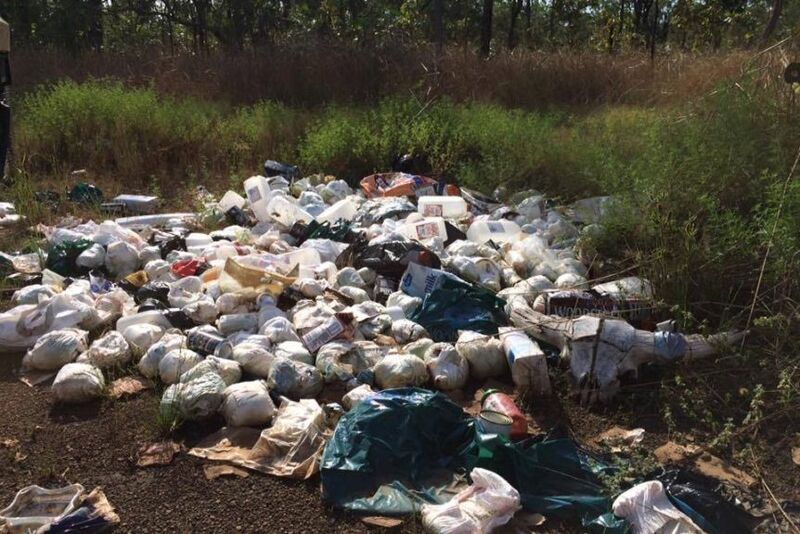
In the first years of a baby, disposable nappies represent a major fraction of general waste for a family.
Disposable nappies are made of a complex mix of different materials: Polyester, Polyurethane, Polyethylene, Polypropylene, Mixture of Polyethylene/Polypropylene, Viscose/rayon, Cotton, Cellulose/pulp fibre, Superabsorbent polymer, Synthetic elastic...
Studies have indicated that some nappies include chemicals that can generate hormonal imbalance for the baby.
It is estimated that those materials take around 500 years to degrade in the environment. This simply means they will completely break down into tiny pieces in that time, but the process itself still has an impact on the environment and will keep having it after the nappy breaks down.
Finally, the biggest problem is that we need them and we need a lot of them. Here’s how many to be exact:
Infographic: How many diapers does a baby use in almost three years?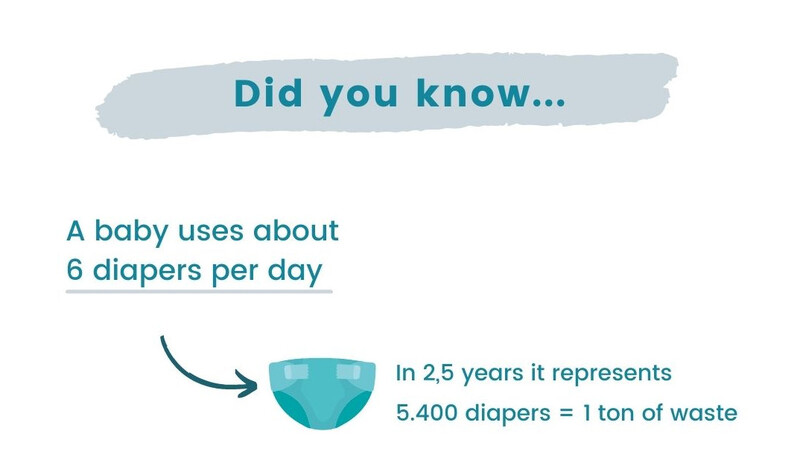
Currently, there is no approved solution to recycle disposable nappies. In Spain (like in a lot of countries), they are considered as sanitary waste, which forbids their potential recycling. A couple of companies are studying recycling processes while others are developing innovative compostable disposable absorbent inserts.
So what solutions do we have available to reduce our impact on the environment related to disposable nappies?
Cloth nappies, but the modern ones!
Before you start thinking cloth nappies are what our grannies used to use with our parents when they were little, let’s start from the beginning!
We’re talking about modern cloth nappies that actually look like disposable nappies. They are easy to clean and are made of modern fabrics that allow perspiration, but prevent leakage.
- Design:
They are designed to fit your baby and are easy to put on. They are fastened by velcro or snaps tabs. You’ll need to follow a couple of tips to make sure the fit is correct and to avoid any leakage, but it’s not rocket science and it’s actually easy to remember. For example, you’ll need to check the elastic bands going around the legs are placed in the groin and not on the leg muscle.
- Crazy poos:
Once you get a hold of how to use them properly, you’ll see they contain crazy poos much better! Way better than any disposable, thanks to the well designed elastic bands around the legs, but also thanks to the waistband which allows no opening or leaking.
- Duration:
Best of all, they can last for about 500 washes. This number varies based on the washing routine and frequency. Generally, they can be used with several children. You can buy and sell them second hand very easily, even here in Spain. Check them out on Wallapop.
- Materials:
The waterproof layer is usually made of PUL, Polyurethane Laminate (except in the case of the hybrid system). The absorbing parts can be made of different types of materials: microfiber, bamboo, cotton, hemp and different combinations of the above, depending on the level of absorption you want to achieve. Some brands use organic bamboo, cotton or hemp and they usually comply with two well known certificates:
Standard 100 by OEKO-TEX™: Testing “numerous regulated and non-regulated substances, which may be harmful to human health” with, in many cases, “limit values for the STANDARD 100 [that] go beyond national and international requirements”.
GOTS (GLOBAL ORGANIC TEXTILE STANDARD): A “textile processing standard for organic fibres, including ecological and social criteria, backed up by independent third-party certification of the entire textile supply chain”.
Now, let’s go down to types and differences in cloth nappies!
There are six clear different types of nappies.
AIO (All-in-One): This is the closest alternative to disposable nappies. All parts (absorbent and waterproof parts) are sewn together.
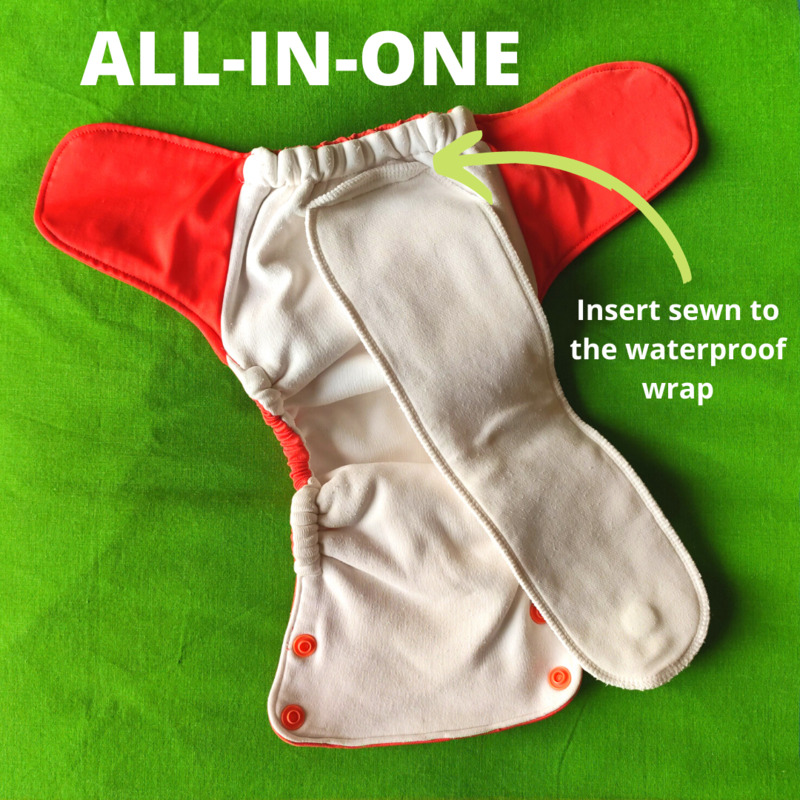
All-in-one reusable diaper.
AI2 (All-in-2) with an insert: This is the most simple design, a waterproof wrap and a rectangular insert for absorption. This allows to change the insert and reuse the wrap or simply rinse and air dry the wrap and reuse while the insert will go through a normal wash.
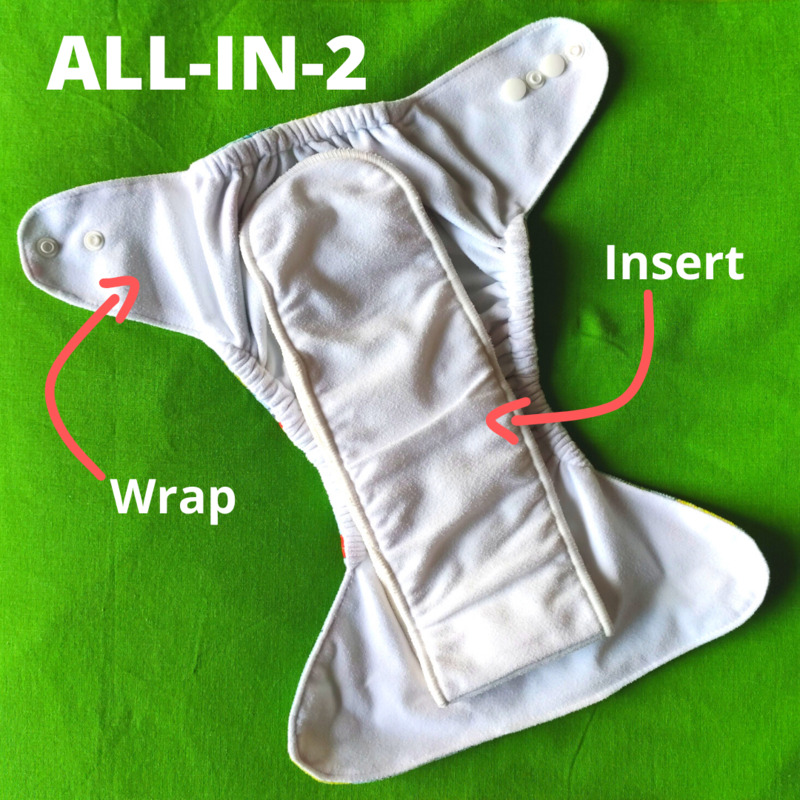
Reusable nappy all in two with insert.
AI2 (All-in-2) with a pocket: this one is very similar to the previous one. The difference is that the wrap has a pocket to slide the insert inside for it not to move. In this case, you cannot reuse the wrap since the pocket itself will be in contact with pee/poo and will be soiled. This type is used like an AIO.
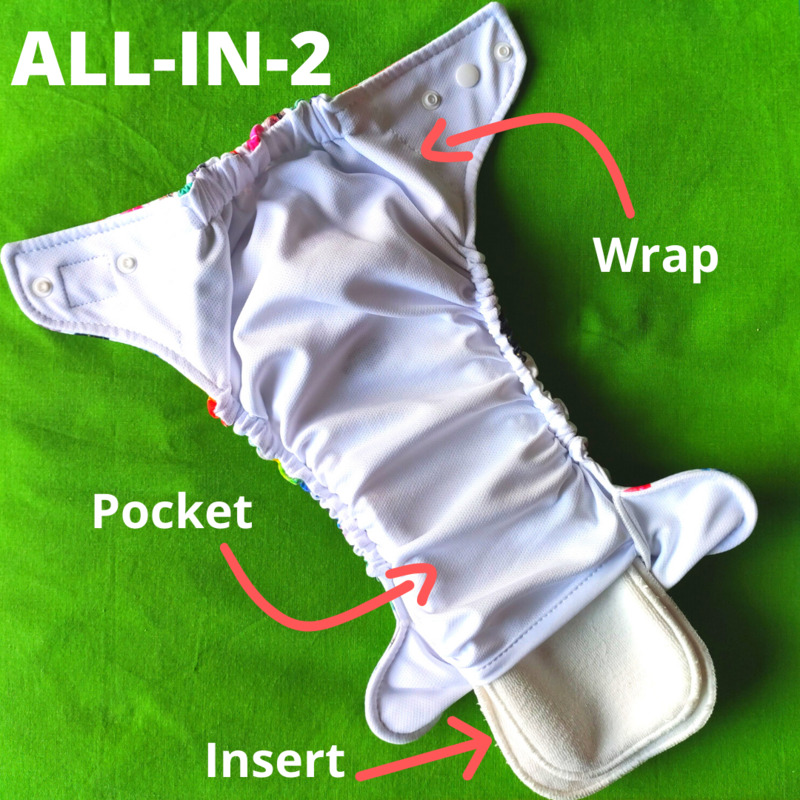
Reusable nappy all in two with pocket.
AI3 (All-in-3)/Hybrid: like the others, this version has a wrap (which does not always perform the waterproof function), a waterproof hammock snapped to the wrap and an absorbent tucked into the hammock. This system allows for reusing the hammock and the wrap without the need to go through a full wash. The wrap should not get soiled since it is protected by the hammock and the hammock usually can be rinsed and quickly air dried before reused.

Reusable nappy hibrid. Photo de Hamac
Prefold/Muslin + wrap: in this case, the fitting happens in two steps. First, the muslin or prefold (absorbing part) is carefully folded and fitted. Then, the waterproof wrap (not shown in the picture) is fitted over the first part. As for the AI2, it is easier to reuse the wrap when not soiled. And muslins are usually easier to clean and they dry faster.
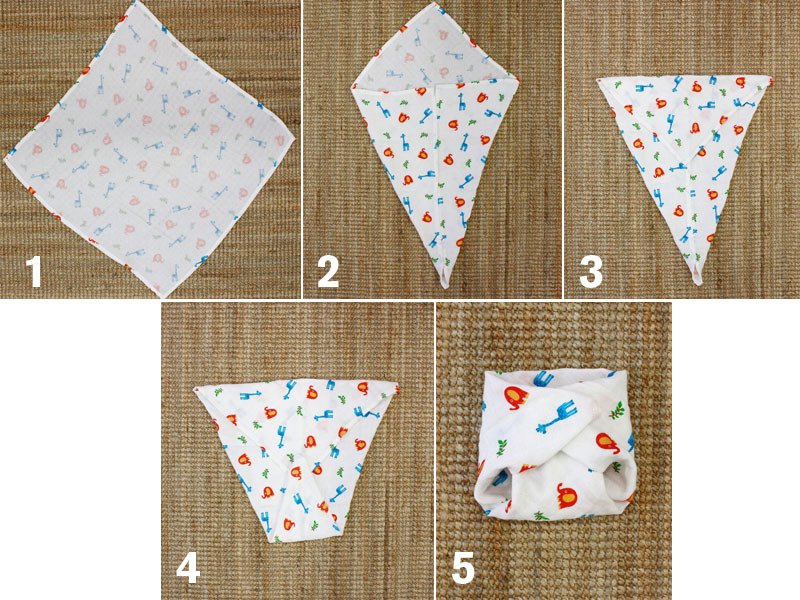
Pre-folded muslin diaper. Photo by Imsevimse
Fitted nappy + wrap: this type of nappy is also fitted in two steps. First, the absorbing shaped nappy is secured. This nappy is not waterproof. This is why as a second step, you need to fit the waterproof wrap over the shaped nappy. It has a big absorbing capacity and is often recommended for the nights.
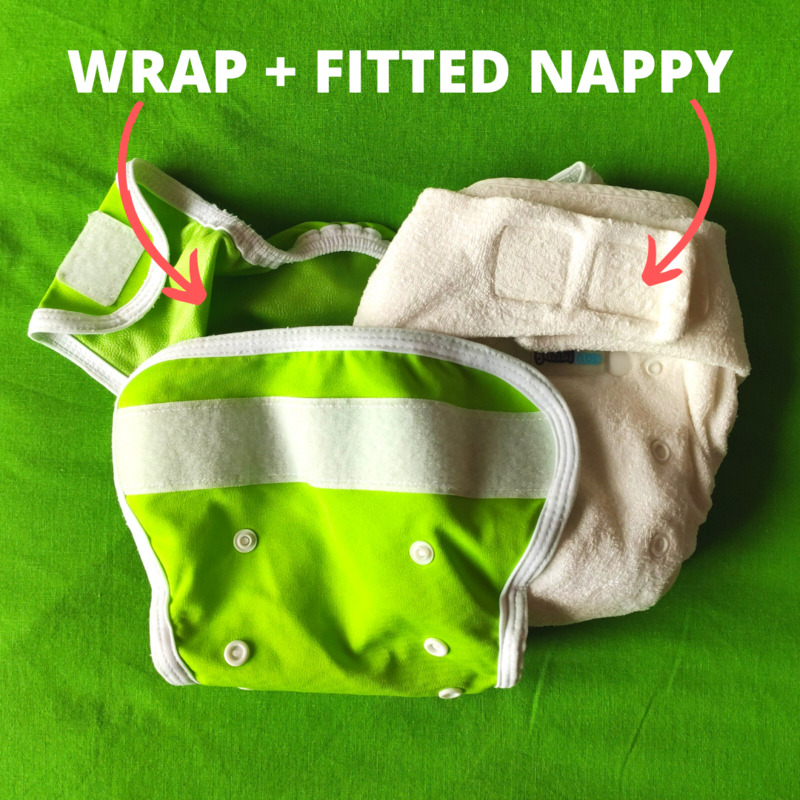
Reusable nappy with wrap and fitted.
So, now you’ve picked the nappy type(s) you like, you’ll need to wash them.
What’s the best washing routine?
Despite what you may have heard, cloth nappies are easy to wash. Still not like our grannies used to do: no boiling for hours involved here!
It is recommended to wash in a normal domestic washing machine.
You’ll have to use 2 programs:
Full rinse cycle on cold temperature, without any detergent. It allows removing any remaining solids.
Normal cotton cycle using a detergent with less than 5% soap as part of the ingredients (to avoid detergent buildup in the fibers). In Spain, you can use Norit (Baby), Bosque Verde (Ropa blanca y de color) en polvo (Mercadona), Skip Ultimate Mimosín. It is important to refer to the manufacturer’s washing instructions as some fabrics may need lower temperatures than others.
Washing by hand is not required. However, you can, if you wish, carry out the rinse cycle by hand.
It is paramount to make sure there is no more detergent after the last spin, since we do not want any detergent buildup. This is because it could make the inserts less absorbent and lead to possible bad smells. In doubt, you can program an extra rinse cycle.
Air drying is the best option as it is the most economical one. Also, the sun has antibacterial and whitening effects. It will help finish removing the last stains in a few minutes.
Sometimes using a liner (disposable or cloth one) can help with dealing with stains as the messiest part will stain the liner and not the nappy itself. Also it will be easier to remove poo. It is up to you to decide to use them or not.
What other options are there to be more sustainable with nappies?
- EC, Elimination Communication
According to the Go Diaper Free website, EC or Elimination Communication is “a gentle, non-coercive way to respond to a baby’s natural hygiene needs, from as early as birth.” You learn your baby’s natural rhythm and signals announcing they are about to pee or poo, so that you can bring them to the potty, without soiling any nappy.
This way you can use much less nappies (regardless of the type) because they will only serve in case of missed signal or sitting too late on the potty.
You can find a lot of information and videos on the Go Diaper Free website.
- pana
You may have felt this sensation of guilt for filling up your bin with disposable nappies every day. pana hire and clean the perfect cloth nappies for your baby without sacrificing your time and energy.
What is pana? How can it help you?
pana deliver clean cloth nappies and pick up soiled ones every other day at your home using a waterproof bag. This way, you can enjoy using cloth nappies with your baby, reducing your waste without investing your time and energy in cleaning them.
pana have selected cloth nappy types that are as easy to use as disposable ones.
You receive them ready to use and you hand them back ready to wash.
How does the pana service work?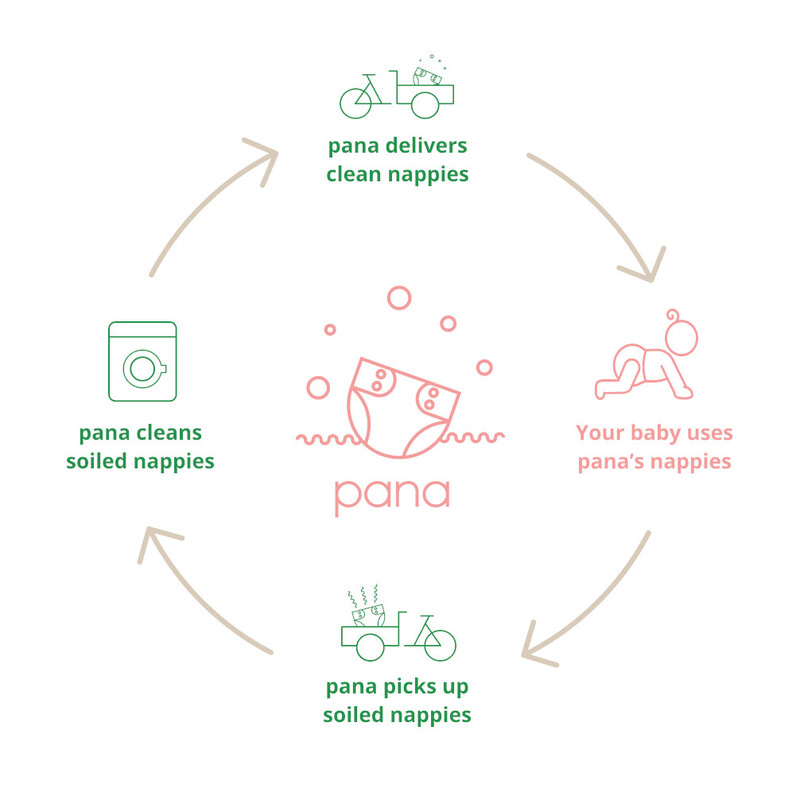
If you would like to try before you buy, pana also hire cloth nappies for the time you need. This way you can experiment with the washing routine or check which types work best for you and your baby.
Finally, if you have your own cloth nappies but want some extra help with washing them, pana can also help you with that.
Currently, the service is available in Barcelona city.
For more information, visit the website

Marie Mélinon
When I realized each baby generates around 1 ton of waste in disposable nappies and wipes, I decided to create pana, a cloth nappy hire and cleaning service, to help families choose this sustainable option.
